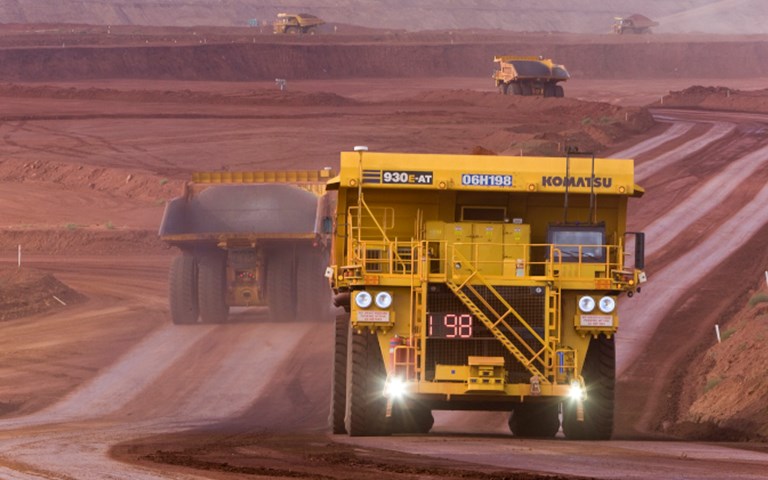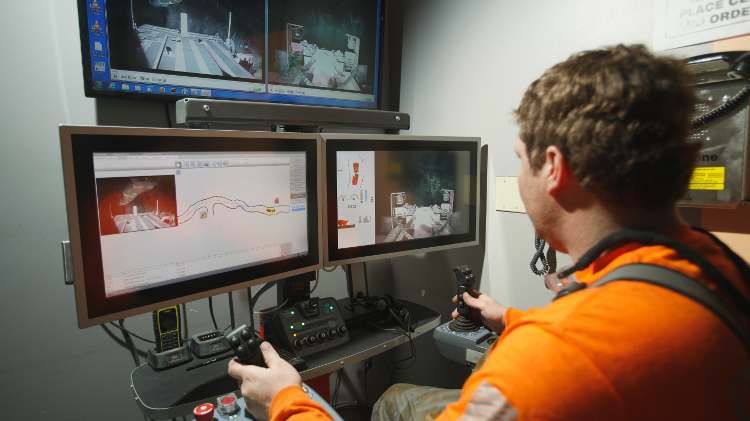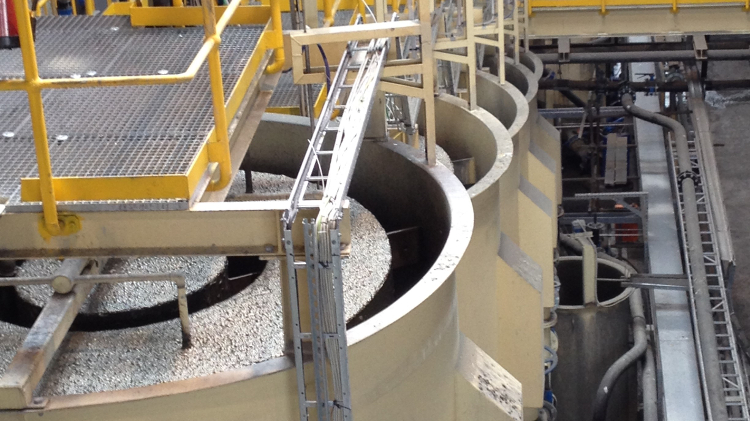Innovation rush in the oil sandsOil sands operators and suppliers alike are trying to find ways to reduce operations costs and cut emissions

Dozens of emerging technologies for almost every facet of oil sands production could be paving the way for solutions to the most significant environmental and operational challenges faced today. In fact, according to a study by the Canadian Energy Research Institute (CERI), these emerging technologies are establishing a foundation for the industry to reduce its operational costs by 40 per cent and its emissions by up to 80 per cent. There is an innovation rush in Alberta’s oil sands and the impacts could be far reaching.
An innovative environment
“Most of us think of innovation in terms of technology but innovation can happen in lots of different ways,” said Dan Wicklum, chief executive of Canada’s Oil Sands Innovation Alliance (COSIA), formed in 2012 by 10 oil companies that account for 90 per cent of oil sands production. “The COSIA model itself is probably one of the biggest innovations in the oil sector.”
Instead of treating innovation as a means to gain a competitive advantage, the COSIA companies collaborate in developing new technologies to improve their environmental and operational performance, said Wicklum. They have already shared $1.4 billion worth of intellectual property for some 985 technologies and innovations. Two years ago, COSIA also launched the international US$20 million NRG COSIA Carbon XPRIZE for CO2 emission-reduction technologies that can convert CO2 into usable products.
“A good innovation system needs good people, good ideas and good funding, but it also needs the testing infrastructure,” said Wicklum. To this end, COSIA partnered with the federal and Alberta governments to create the Alberta Carbon Conversion Technology Centre (ACCTC) in Calgary, which opened in May. Built adjacent to the Shepard Energy Centre, which provides flue gas emissions from a natural gas-fired power plant, the new facility enables innovators with the capabilities to test, refine and scale-up technologies for commercialization that convert CO2 into usable products.
In April, COSIA announced the 10 finalists for the Carbon XPRIZE. Each will receive a US$500,000 award to take their technologies to a commercialization-ready stage. Five of the finalists are focused on gas-based CO2 conversion and will be the ACCTC’s first tenants. (The teams focused on converting coal-based CO2 will go to Wyoming’s Integrated Test Center.) Using CO2, Carbicrete turns steel slag industrial waste into cement-free concrete, CERT creates value-added fuels and feedstocks, Newlight fabricates bioplastics, Carbon Upcycling Technologies builds graphitic nanoparticles and graphene derivatives, and C2CNT manufactures nanotubes. Along with the finalists in Wyoming, they will be scaling up their technologies for commercialization as they compete for one of the two $7.5 million grand prizes, which will be awarded in 2020.
Autonomous haul systems
With oil sands haulage fleets as big as they are, the potential for automation is obvious, but its implementation has demanded creative thinking to contend with the difficult conditions in the region.
For Komatsu, which has worked with Suncor since 2013 on adapting the OEM’s autonomous haulage systems (AHS) that it has rolled out in the Pilbara iron range of Western Australia, the oil sands posed unique challenges, namely the cold winters and the soft underfooting of the ore bodies. Winterizing and the development of a multi-trajectory system to prevent the trucks from damaging the roads resolved the challenges.
Suncor is planning to add 150 AHS units at its oil sands mines over the next six years, starting with the North Steepbank mine. It is not the only oil sands mining company considering the new technology. Canadian Natural Resources is planning a small pilot project for 2019.
Komatsu’s AHS combines autonomous trucks with manned support equipment and shovels. “We have five layers of safety to allow humans to interact with the autonomous trucks,” said Brian Yureskes, director of Komatsu’s business development for the oil sands. “Some of those are virtual layers of safety so the system is able to see and anticipate what humans are doing around the trucks. Some are physical layers such as lasers and radar. The final layer is that every single piece of equipment that is manned and operated in the area has a big red button that, when you push it, stops all the autonomous trucks.”
According to Scott Schellenberg, senior manager of AHS for SMS Equipment, the Canadian distributor for Komatsu, the autonomous technology itself has increased safety. “Humans working around the autonomous haulers can see on their screens where the trucks are and know where they are headed versus with a human driving the truck,” he said.
The digital oil sands
The oil sands are increasingly adopting machine learning and artificial intelligence technologies, said Dinara Millington, vice-president of research at CERI. “I’m noticing it’s happening faster now that these technologies have been in the commercial space for a little while,” she said.
Marty Reed, CEO of Evok Innovations, a partnership between Canada’s oil and gas companies and the BC Cleantech CEO Alliance, points to two innovative companies with technologies that have powerful benefits for the oil and gas sector as well as the oil sands. One is Kelvin, which has an artificial intelligence system that has been deployed in BP’s oil and gas fields in Wamsutter, Wyoming. There, hundreds of inexpensive sensors have been installed in the wells where they gather data that is transmitted via the cloud to powerful computers. These identify patterns and form predictions, which are used to create optimization tweaks that are sent back down to the controls in the field.
“The days of one shift coming in and tweaking all the dials is going to go away,” said Reed. “Computers do it better.”
The second company is Expeto, founded in Victoria, B.C., which offers a software-based solution that securely connects LTE devices. “If you can’t get that data up to the cloud, it doesn’t really do us any good,” said Reed. “Expeto is giving a platform to provide enterprises much greater control for all their internet devices. They’re working in oil and gas and mining.”
Trim the footprint
The oil sands industry currently emits some 70 megatonnes of CO2 a year. In 2030, an Alberta government cap on allowable CO2 emissions of 100 megatonnes per year will come into effect. If the industry wants to keep growing, it has a relatively small window of time to cut its CO2 intensity.
In 2015, Shell Canada opened the world’s first commercial-scale carbon capture and storage facility for an oil sands operation, named Quest Carbon Capture and Storage facility and located at the company’s Scotford bitumen upgrader near Edmonton. Three years later, the plant has captured and stored more than three million tonnes of CO2. The system, designed by Shell, uses amine to absorb CO2 from the gas flue. It then separates the CO2 from the amine and pressurizes it into a liquid, which is transported 65 kilometres north by pipeline where it is injected two kilometres into the ground.
Another technology that has been developed to reduce greenhouse gas emissions is Quebec-based CO2 Solutions’ enzymatic CO2 capture technology. The process is currently being demonstrated within a $30-million carbon capture and utilization project at Chimie Parachem, a paraxylene facility in Montreal that is 51 per cent owned by Suncor. Construction is underway for the first commercial unit, destined for, a Resolute Forest Product pulp mill in Quebec. It is expected to be commissioned by the end of the year and will feed captured CO2 to a nearby greenhouse. The company has worked extensively with the oil sector to demonstrate its technology, which can be scaled up and comes with a lower capital and operating cost than amine-based technologies, according to Evan Price, CO2 Solution’s president and CEO.
 CO2 Solutions' enzymatic CO2 capture technology. Courtesy of CO2 Solution
CO2 Solutions' enzymatic CO2 capture technology. Courtesy of CO2 Solution
The core of the technology is a carbonic anhydrase enzyme, which is also used in human and animal lungs to manage CO2 in their bodies. CO2 Solutions compares its technology to the equivalent of an industrial lung. “We’re using a very simple carbonate salt solution that generates no aerosols and no toxic wastes,” said Price. “The heat required for our technology comes from hot water drawn from the host plant, as opposed to steam, which is required for amine processes. As steam has a lot of value, the use of hot water provides our technology with an advantageous and important cost differential.”
Accelerating the reclamation of the oil sands mining operation is also a pressing project that has sparked an array of approaches from both inside the industry and out. Among the many contenders is Calgary-based Technika Engineering, which observed the issues with conventional mature fine tailings (MFT) reclamation technologies using dredges and barges with submersible pumps.
“We thought there had to be a better approach,” said Radé Svorcan, the company’s president. “So we set out to design it.”
Technika has developed what it calls the Tailings Recovery System (TRS). Oil sands MFT have considerable shear strength and viscosity that increase with the depth of the ponds, which typically reach 30 metres deep. Due to debris in the MFT and its rheology, conventional technologies using dredges and barges with submersible pumps encounter MFT dilution at the suction point, and clogging. TRS technology uses a caisson-type telescoping shell structure located at the pond surface that can go down to a 15-plus metre depth to leverage the principle of hydraulic pressure balance to bring MFT to the surface. “Because the MFT is on the surface within the TRS, it’s much easier to recover it and the challenges of MFT dilution and pump clogging are addressed. We are using the natural hydraulics to draw the MFT up,” said Svorcan.
 Technika Engineering's Tailing Recover System (TRS). Courtesy of Technika Engineering
Technika Engineering's Tailing Recover System (TRS). Courtesy of Technika Engineering
The benefits of the technology, which has already been successfully deployed at an oil sands operation, is that it allows for year-round reliable clogging-free recovery. It is fully winterized and can be remotely operated. On a 2,500 m3/h MFT supply system, TRS results in $10 to $20 million savings in capital costs and $5 to $10 million in annual operating costs compared to barge or dredge technologies, according to the company.
Innovating in situ extraction
When two imaging technology entrepreneurs, Stephen Robinson and Graham Manders, partnered with an oil and gas veteran, Osman Malik, and started asking oil companies in Alberta’s oil sands about their needs, their response to the feedback was to create DarkVision Technologies. “Everyone wanted to be able to see inside their wells,” said Robinson. “Wells are quite complicated and operators want to see inside them to fix problems and optimize production, yet wells are deep, dark and filled with opaque fluids.”
 DarkVision imaging scan of broken production tubing inside of a casing. Courtesy of DarkVision Technologies
DarkVision imaging scan of broken production tubing inside of a casing. Courtesy of DarkVision Technologies
In 2013, DarkVision developed a high-resolution acoustic-based imaging technology that allows operators to see inside their wells through murky fluids. Last year, the company expanded its offices to Calgary and now has five different customers, including Suncor, MEG and ConocoPhillips. “We have many more complementary products to develop, so we’re not anywhere near done,” said Robinson.
In the world of in situ oil sands extraction, there is a lot of buzz about solvent-based technologies to replace water and gas-guzzling conventional steam-injection technologies to make the bitumen that is too deep to be mined less viscous so it can be collected and pumped to the surface.
One of these is HeatWave, developed by U.S.-based Harris. The system uses the Enhanced Solvent Extraction Incorporating Electromagnetic Heating (ESEIEH) process, a combination of solvent dilution and electromagnetic heating with a radio frequency antenna placed into the ground that heats the bitumen.
Another company, Calgary-based Nsolv, has developed a waterless solvent-based system that was piloted for three years in the oil sands. That project ended in 2017 after successfully producing 130,000 barrels of oil. The technology is now ready for commercial deployment.
Related/: A double solution to acid mine drainage and wet tailings dam failure
Nsolv injects pure, heated propane vapour from a low pressure plant into the bitumen reservoir. When the vapour reaches the bitumen, it condenses and mildly heats the bitumen. “Liquid propane and slightly mobile bitumen mix readily,” said Joseph Kuhach, Nsolv’s CEO. That liquefies the bitumen enough to bring it up to the surface.
Compared to steam-assisted gravity drainage (SAGD), the process reduces greenhouse gas emissions by 70 to 80 per cent and eliminates the need to build a large water plant, said Kuhach, which results in a 40 per cent savings in capital costs.
Additionally, Kuhach said, the Nsolv process sequesters asphaltenes in the reservoir.
This partially upgraded bitumen requires less than half the diluent necessary to meet pipeline specifications compared with typical bitumen production. Currently in Western Canada pipelines require a 20 to 22 degree American Petroleum Institute gravity rating. Most bitumen today has an 8 to 10 degree rating while Nsolv-produced bitumen rates at 13 to 14 degrees.
Cutting the amount of diluent in pipelines has far more important implications for the oil sands than a reduction in diluent costs alone. Some 30 to 40 per cent of bitumen transported through pipes is not actually oil. It is diluents, an inefficiency that is more pronounced given the frustrated attempts to expand the pipeline network.
Pushing more oil through the bottleneck
“If no new pipelines are being built, how can you increase the throughput?” asked Millington. “One way is to reduce the amount of diluent that all bitumen requires in order to meet pipeline specifications so the diluent doesn’t take up valuable pipeline capacity.”
Oil sands companies and innovators have been working on the development of partial upgrading technologies that can increase the amount, quality and value of bitumen transported from the oil sands.
Quebec-based Fractal Systems, for example, has developed and tested a system called Enhanced JetShear partial upgrading technology. In February, the company announced that JetShear can reduce diluent by 50 to 60 per cent and increase bitumen capacity in the pipeline by 20 to 25 per cent. The JetShear system relies on hydrodynamic cavitation and mild thermal cracking to structurally modify the bitumen’s asphaltene molecules at the extraction site and reduce its viscosity and bulk density. Fractal has said its technology, which includes proprietary jet nozzles, is now ready to be commercialized.
As well, Alberta Innovates has partnered with a number of companies whose partial upgrading technologies are at the demonstration scale, which requires an operation of 1,000 barrels per day, said Murray Gray, senior technical advisor of bitumen partial upgrading at Alberta Innovates. One company is MEG Energy, whose system will deliver pipeline-ready partially upgraded bitumen without using any diluents. Called HI-Q, the technology uses a combination of thermal cracking and deasphalting. Another is Nexen Energy, whose process, BituMax, also combines deasphalting with thermal cracking but in the reverse order of HI-Q. Husky Energy is taking a different tack. Its system blends the bitumen with some synthetic crude then processes the mixture.
“We expect that in two to three years’ time, we’ll have several new partial upgrading technologies that will be available for commercial deployment,” said Gray.
In these times of uncertainty, commercialization becomes challenging. According to the Canadian Association of Petroleum Producers, total capital spending at the oil sands shrunk to about $15 billion in 2016, down from about $34 billion in 2014.
“How do you invest capital in something that hasn’t been commercially proven?” said Millington. “The first company that comes out the gate with the new technology takes the most risk. So the question is how to de-risk some of this and speed up the process to commercialization.”
In February, the Alberta Government announced at least a partial solution: $1 billion in loans and grants over the next eight years to help build partial upgrading facilities in the province. “We see the government’s partnership as being very important to help these technologies get over the barrier of demonstration at sufficient scale,” said Gray.
No one technology can solve all the oil sands challenges but “the potential is there for innovative technologies to dramatically transform the oil sands,” said Millington.
More Technology

The automation revolution
There is no doubt the future of mining is automation. But what does that look like, and how will we get there?

The future of flotation
Buoyed by pressure to cut costs and improve recovery, new flotation technologies are on the rise

